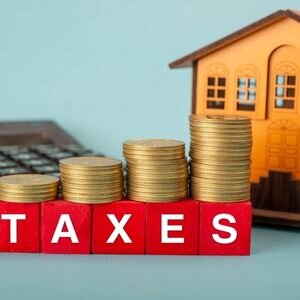
Understanding Property Tax Rates in Grapevine, Texas
A complete understanding of the variables that affect Grapevine, Texas property tax rates is necessary for comprehending these rates and their effects on homeowners. The Tarrant County Appraisal District determines the market value of homes annually, which in turn determines Grapevine’s property taxes.
The total property tax rate is a combination of rates set by various local entities, including the city of Grapevine, Grapevine-Colleyville Independent School District, and Tarrant County. These rates fund essential services such as public education, infrastructure maintenance, and emergency services.
Adjustments to local government budgets or changes in assessed property values might cause tax bills for Grapevine homeowners to fluctuate. Factors that can lower taxable value, such as homestead or senior citizen exemptions, must also be considered.
Staying informed about property tax rates empowers homeowners to plan their finances effectively and appeal assessments if necessary.
Factors Influencing Property Tax Rates in Grapevine, TX
Several key factors that homeowners should understand to manage their financial responsibilities effectively influence property tax rates in Grapevine, TX. One primary factor is a property’s assessed value, which is determined by the Tarrant County Appraisal District and reflects both market conditions and any improvements made to the home.
Grapevine’s economic growth and development are also very important. This is because rising demand for public services like schools, roads, and emergency services can cause tax rates to change in order to pay for them. Also, local government budgets have a big effect on property taxes. Rates can change when the city council decides how much money to give to community programs or building projects.
Exemptions to specific groups, such as seniors or veterans, affect overall tax revenue needs. Lastly, changes in state legislation regarding property taxes can directly alter how much residents are required to pay annually.
Homeowners can better understand their property tax responsibilities when they know about these factors.
Historical Trends of Property Tax Rates in Grapevine
Over the years, property tax rates in Grapevine, Texas, have experienced significant fluctuations due to various economic and policy factors. Historically, the city has adjusted its property tax rates in response to changes in local government funding needs and economic conditions.
In the early 2000s, Grapevine had a fairly stable time, with small hikes that kept pace with inflation and rising demand for public services. But as the neighborhood grew quickly and the population grew, property prices skyrocketed. This made municipal officials rethink tax rates to find a balance between the city’s financial obligations and the residents’ financial burdens.
During the recession of the late 2000s, there was a greater emphasis on keeping tax rates low to draw in new residents and businesses while still making sure that there was enough money for basic services like schools and infrastructure upkeep. As Grapevine continues to grow into a successful suburban center in the Dallas-Fort Worth metropolitan area, property tax rates have been changed from time to time to reflect both the economy’s recovery and the rising value of real estate.
This changing environment makes it even more important to know about past trends when looking at Grapevine’s current and future property tax liabilities.
How Grapevine’s Property Tax Rate Compares with Neighboring Cities

Property taxes significantly affect homeowners’ annual expenses. C in Grapevine, Texas, compared to neighboring cities such as Southlake, Colleyville, and Keller, Grapevine’s property tax rate presents a competitive landscape for potential homebuyers. While some choose to sell your house in Sherman due to its urban appeal, Grapevine offers a strong balance of services and tax advantages.
Grapevine’s rate is influenced by local government budgets and school district funding needs, which are common factors across the region. Although Southlake may have slightly higher rates due to its luxury real estate market and robust public services, cities like Keller often offer lower rates, appealing to those seeking more affordable housing options.
Because of their shared municipal service levels and educational goals, Colleyville and Grapevine are often seen as being very similar. Homeowners and potential buyers alike should familiarize themselves with these distinctions while considering the area’s long-term financial commitments. The Southern Hills Home Buyers team offers local expertise that helps residents navigate these differences and make informed real estate decisions in Grapevine and beyond.
By analyzing Grapevine’s property tax rate against its neighbors, residents can make informed decisions about their investments and community contributions while considering the benefits of living in this vibrant part of North Texas.
Calculating Your Property Taxes in Grapevine, Texas
Calculating your property taxes in Grapevine, Texas, involves understanding several key factors that influence the amount you owe. First, the appraised value of your home plays a critical role in determining your property tax rates.
The Tarrant County Appraisal District assesses this value annually, considering market trends and property characteristics. Once the appraisal is complete, local taxing entities like the Grapevine-Colleyville Independent School District and city authorities set their respective tax rates.
Budgetary demands for public safety, infrastructure repair, and education determine the percentage form of these rates, which are called millage rates. Your property tax amount will be determined by multiplying your home’s assessed value by the sum of all applicable taxing units’ millage rates.
Homeowners may qualify for exemptions that reduce taxable value, such as homestead or senior citizen exemptions, which can significantly decrease the overall tax burden. Understanding these elements is essential for homeowners in Grapevine to estimate their annual property tax obligations and plan accordingly accurately.
Impact of Property Value Assessments on Tax Rates in Grapevine
The property tax rates that homeowners in Grapevine, TX are ultimately responsible for paying are heavily impacted by appraisals of their homes’ worth. In order to determine how much a property is owed in taxes, the appraisal district conducts annual property evaluations to determine the fair market value of each home.
As property values increase, so do the assessed values, potentially leading to higher tax bills for homeowners. Grapevine’s local government relies on these assessments to fund essential services such as public schools, infrastructure maintenance, and emergency services.
Homeowners who want to be prepared for changes in their financial commitments would do well to familiarize themselves with the relationship between property value fluctuations and tax rates. Each homeowner’s contribution to the community’s revenue through property taxes is directly affected by the link between assessed value and the actual tax rate, which can be complex.
Keeping track of annual assessments and any appeals process available can help homeowners manage their expenses more effectively while ensuring they are not overpaying due to inflated valuations.
Exemptions and Deductions Available for Property Owners in Grapevine
Some Grapevine, TX, property owners may be able to reduce their tax bills by taking advantage of certain deductions and exemptions. The homestead exemption is a popular one because it lowers the total amount of property taxes paid by a major residence by reducing its taxable value.
Seniors aged 65 and older, as well as disabled homeowners, may qualify for additional exemptions that further reduce their tax liabilities. Veterans partially or fully disabled due to service-related injuries might also be eligible for significant property tax reductions under specific veteran exemptions.
In addition, if the site satisfies certain requirements for farming or ranching, it can result in lower assessments under laws for agricultural land use. Homeowners in Grapevine can save a ton of money on property taxes if they know about and take advantage of these exemptions.
How to Appeal Your Property Tax Assessment in Grapevine, TX
If you think the property tax assessment in Grapevine, TX, is wrong, it’s important to know how to appeal it properly. To figure out the value of your property and compare it to similar homes in your neighborhood, start by carefully reading your appraisal notice.
Gather evidence such as recent sales data, photographs, and any documentation that supports your claim for a lower valuation. You can then file a formal protest with the Tarrant Appraisal District by the deadline stated on your notice.
Be prepared to present your case during an informal meeting or a formal hearing before the Appraisal Review Board (ARB). Clearly articulate why you believe the assessed value is inaccurate, using your collected evidence.
If you know the local property tax laws and rules, your argument will be stronger. If you need help, think about hiring a property tax consultant. They can provide you expert advice and make it more likely that your appeal will be successful.
The Role of Local Government in Setting Property Tax Rates in Grapevine

The municipal government in Grapevine, Texas, is very important in setting property tax rates, which are necessary for paying for important community services. The city council works with several local agencies to figure out how much money the city needs and set tax rates that will bring in enough money for public schools, infrastructure upkeep, emergency services, and recreational facilities.
Property assessments conducted by the Tarrant County Appraisal District serve as a foundation for calculating individual property taxes, reflecting current market values within Grapevine. Throughout this process, public meetings and hearings allow residents to voice their opinions and concerns about proposed tax changes.
By balancing fiscal responsibility with community needs, the local government strives to maintain a fair tax rate structure that supports both homeowners and the city’s growth objectives.
Funding Public Services Through Property Taxes in Grapevine, Texas
Essential public services that contribute to the well-being and infrastructure of Grapevine, Texas, are funded in large part by property taxes. Local schools are able to provide high-quality education to children because of the money that comes from property taxes.
The police and fire departments, which ensure the protection of all citizens, are also funded by these levies. Revenue from property taxes also goes toward funding public libraries and parks, which in turn provide recreational areas and other amenities that improve the quality of life in the community.
Furthermore, property taxes maintain roads and public transportation systems, facilitating smooth travel throughout Grapevine. Understanding how these funds are allocated helps homeowners appreciate their contributions’ direct impact on sustaining and improving the quality of life in Grapevine.
Frequently Asked Questions About Grapevine’s Property Taxes
In order to better understand their financial responsibilities, homeowners in Grapevine, TX must have a firm grasp of the current property tax rates. The methodology used to establish these property tax rates is a common point of inquiry.
In Grapevine, the tax rate is influenced by the appraised value of a property, which is assessed annually by the Tarrant Appraisal District. Many homeowners ask about potential exemptions or reductions; fortunately, options such as homestead exemptions and senior citizen discounts can lower the taxable amount.
Another common inquiry relates to how often property values are reassessed and whether this impacts tax bills annually. These values can fluctuate based on market conditions and local government budget needs, thus affecting the taxes owed each year.
Residents also often seek information on where their property tax dollars go; typically, these funds support essential services like public schools, infrastructure maintenance, and city operations in Grapevine. Understanding these aspects helps homeowners plan better financially and ensures they are well-informed about their contributions to community funding through property taxes. For more information, check out other frequent questions about selling your home and property tax concerns in Texas.
Planning for Future Increases: Managing Your Budget with Rising Taxes
Homeowners in Grapevine, TX would do well to prepare ahead and budget for any hikes to their property tax rates. Residents can better prepare for any increases if they are knowledgeable about the elements that influence these taxes and how they are calculated.
Property taxes in Grapevine are determined by multiplying the assessed value of a home by the local tax rate, which can fluctuate due to changes in municipal budgets, school district funding requirements, and economic conditions. Homeowners should stay informed about local government meetings and budget proposals to understand possible rate changes.
Residents can manage their budgets more effectively by setting aside funds for anticipated tax increases or adjusting household expenses accordingly. Regularly reviewing your home’s assessed value and appealing if necessary can ensure you are not overpaying on property taxes.
To find out more ways to lessen the blow of increasing taxes on your finances, you can talk to local officials or a financial adviser who is well-versed in Texas property taxes.
Comparing Residential and Commercial Property Tax Rates in Grapevine, TX

Understanding the differences between residential and commercial property tax rates is crucial for property owners in Grapevine, TX. Residential properties typically face a different tax rate than commercial properties due to variations in valuation and assessment methods.
The city of Grapevine applies distinct criteria when assessing these two types of properties, often resulting in lower residential property taxes than those for commercial properties. This discrepancy arises because commercial properties, including retail spaces and office buildings, are usually valued higher based on income-generating potential.
Consequently, they contribute more significantly to the local tax base. Residential property taxes in Grapevine are primarily influenced by location, home size, and market value fluctuations.
Meanwhile, commercial property owners must consider additional elements like business type and zoning regulations that can affect their overall tax liability. Understanding these differences helps residents and investors make informed decisions regarding their real estate investments in Grapevine’s dynamic property market.
Is It Expensive to Live in Grapevine, TX?
Compared to other regions of Texas, Grapevine is very expensive due to its appealing location and great quality of life. The rates of property taxes are a significant part of the cost of living in Grapevine.
The property taxes in Grapevine are based on how much the homes are worth. The rates are set by local taxing bodies like the city government, school districts, and county officials. Grapevine’s property taxes may seem high compared to those in some nearby areas, but they are actually a reflection of how much the city spends on keeping its schools, public services, and infrastructure in great shape.
Homeowners in Grapevine should consider these property tax implications when budgeting for homeownership costs. Additionally, the desirability of living in this vibrant community with its proximity to Dallas-Fort Worth International Airport and numerous recreational amenities often offsets the higher property taxes for many residents seeking a balanced lifestyle.
When deciding if living in Grapevine is within your budget, it’s important to know how these property tax rates affect your money.
What City in Texas Has the Highest Property Taxes?
When we talk about Texas property tax rates, it’s important to note that they change a lot from city to city. It’s important for Grapevine homes to know their property tax rates, but it’s interesting that some Texas cities have much higher property taxes.
For instance, the city of Austin is often cited as having one of the highest property tax rates in the state. This is due to high property values and municipal budget requirements.
Understanding these variations is crucial for potential homeowners or investors looking at properties in Grapevine and throughout Texas. By comparing the relatively moderate property tax rates in Grapevine with those of larger metropolitan areas like Austin or Dallas, or even when selling a house for cash in Rockwall, residents can better understand their financial obligations and opportunities within the real estate market.
What Is the Property Tax Rate in Hardin County, Texas?
Although the primary focus of our study is on Grapevine, TX property tax rates, it is helpful to compare these rates to those in other places, such Hardin County, TX. Because of differences in school district funding and local government budgets, property tax rates in Texas vary greatly throughout municipalities and counties.
In Hardin County, the property tax rate is determined by various taxing entities, including county governments, school districts, and special districts like hospital or utility districts. As of the latest assessment period, homeowners in Hardin County can expect a combined property tax rate that typically ranges around 2% to 3% of the assessed home value.
This percentage includes contributions from all relevant taxing authorities. Homeowners should understand how these rates are applied to their property’s assessed value since this directly impacts their annual property tax bill.
Comparing these rates with those in Grapevine provides valuable insights into regional tax burdens and helps potential homebuyers make informed decisions when purchasing real estate in Texas. To make the most of your investment, consider Exploring Grapevine, TX: A Comprehensive Guide To Neighborhoods to better understand the character, amenities, and long-term value each area offers.
Helpful Grapevine Blog Articles
- Selling My House On My Own In Grapevine
- Best Things To Do In Grapevine With Kids
- Grapevine Property Managers
- Optimal Seasons For Selling Your Home In Grapevine, TX
- Understanding Property Tax Rates For Homes In Grapevine, TX
- Exploring Grapevine, TX: A Comprehensive Guide To Neighborhoods
- Your Real Estate Transactions With The Grapevine, TX Housing Excise Tax Calculator
- Exploring Grapevine, TX: A Guide To The Best And Worst Neighborhoods For Real Estate
- Affordable Housing Options In Grapevine, TX: Discover The Best Value Neighborhoods
- Exploring Denton, Tx: Safety Insights For Homebuyers And Real Estate Investors

| TAX PAYMENT | TAX BASED | REAL ESTATE TAX | TARRANT COUNTY, TX | TARRANT COUNTY, TEXAS | PAYMENT |
| CREDIT | CREDIT CARD | STATE OF TEXAS | FISCAL YEAR |
